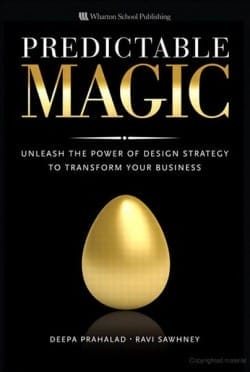New isn’t always better.
After all, it is said that up to 80 percent of all new products fail.
Which begs the question: What is it specifically about the design, strategy and utility of those other products—the ones that do succeed? What sets the 20 percent apart from the 80 percent?
According to award-winning industrial designer Ravi Sawhney and business strategist Deepa Prahalad, the answer isn’t just design, but rather design combined with strategy.
In Predictable Magic: Unleash the Power of Design Strategy to Transform Your Business, published by Wharton School Publishing, Sawhney and Prahalad make the case that the creators of super-successful products often find a way to seamlessly integrate corporate strategy with design.
In other words, they don’t deliver utilitarian objects: They craft rewarding, empowering experiences.
To outsiders, this looks like magic: incomprehensible and impossible to reproduce. But it isn’t, the authors say, and in Predictable Magic they present the complete design process for making the “magic” happen—over and over again. Sawhney and Prahalad introduce “Psycho-Aesthetics,” a breakthrough approach for systematically creating deep emotional connections between consumers and brands.
Step by step, Predictable Magic will teach you everything you need to know to make Psycho-Aesthetics work, from research to strategy, implementation to consumer experience. You’ll also see it at work in case studies from some of the world’s top companies, including Medtronic and Amana, as well as innovative start-ups.
Financing the Future: Market-Based Innovations for Growth
By Franklin Allen and Glenn Yago
Financial innovation has done a lot of good for the world.
Starting with the use of credit in Assyria and Babylon over 3,000 years ago and development of the bill of exchange in the 14th century, financial innovation has driven social, economic and environmental change worldwide, transforming ideas into new technologies, industries and jobs.
Yet when financial resources are misunderstood or mismanaged—as they were most recently during the events leading up to the current financial crisis—the consequences can be severe.
In Financing the Future: Market-Based Innovations for Growth, two leading experts—Franklin Allen, Wharton’s Nippon Life Professor of Finance and Professor of Economics, and Glenn Yago, Director of Capital Studies at the Milken Institute—explain how sophisticated capital structures can enable companies and individuals to raise funding in larger amounts for longer terms and at lower cost, thereby accomplishing tasks that would otherwise be impossible.
The authors recount the history and basic principles of financial innovation, showing how new instruments have evolved—as well as how they have been both used and misused. In this important and highly readable book, Allen and Yago thoroughly demystify complex capital structures, offering a practical toolbox for entrepreneurs, corporate executives and policymakers.
Financing the Future presents clear, thorough discussions of the current role of financial innovation in capitalizing businesses, industries, breakthrough technologies, housing solutions, medical treatments and environmental projects. It also presents a full chapter of lessons learned: essential insights for stabilizing the economy and avoiding pitfalls.


























